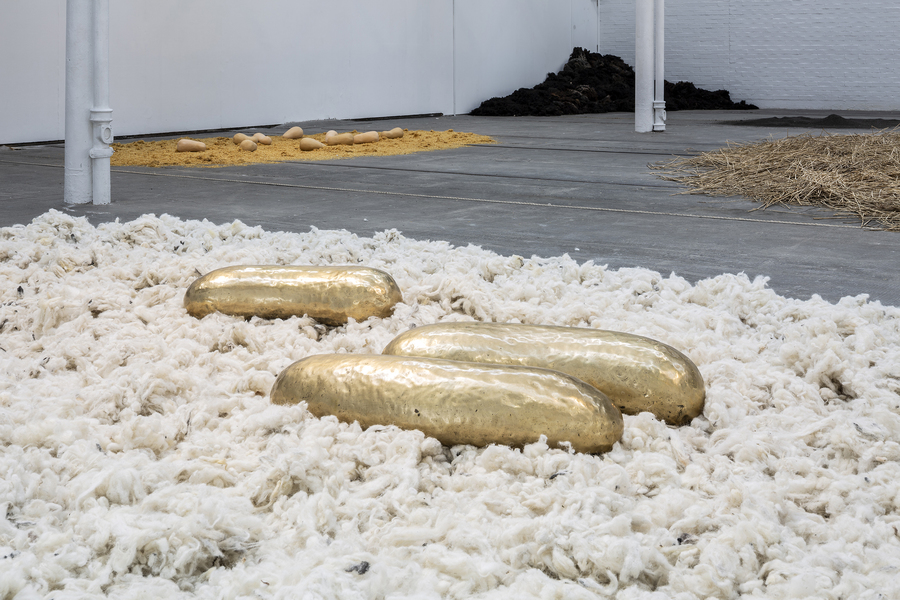Solange Pessoa, Pilgrim Fields @ Tramway, Glasgow
Brazilian artist Solange Pessoa’s exhibition at Glasgow’s Tramway probes humanity’s symbiotic relationship with the Earth through large-scale sculptural works created between Glasgow and Brazil
Stepping into the gallery, an almost solid, brilliant smell of nothing in particular marks the beginning of Solange Pessoa’s fantastical lifeworld, Pilgrim Fields. A rather literal recreation of its title, the installation forms pathways for walking around colourful beds of seeds, flowers, leaves, fruits, wool, and sculptures; moss sprouts from the crevices of the floor. Made of ceramic or bronze, sculptures that resemble seeds, legumes and standing stones (from Bronze Age Scotland) are laid amidst, or nest on top of, beds of marigold petals, chamomile flowers, and wool. Capturing the sunlight from the ceiling, the bronze, gold-like sculptures resemble ex-votos, religious offerings in Indigenous traditions and religions. The dense arrangement of the earthborn and sculpted materials dictates a careful wandering. The height of the room and descending light contribute to a quasi-religious or enchanted experience, activating a sensuous relationship between humans and the natural world. Pessoa’s practice is informed by an animist worldview, in which the material and spiritual, human and ‘other’ (animal, plant, or inorganic matter) are understood as parts of an interconnected whole.
On the other hand, the compartmentalised arrangement of the earthborn material in distinct piles elicits a sort of distance, a mediation. In a map of this imagined ecosystem, each pile is titled quite literally; an inventory: Scottish cultivated sphagnum moss; Niger seeds; Bellani pumpkin, natural and dried; Raw Hebridean wool; Safflower seeds; Butternut squash. Through this tension between natural order and logistical listing, we can begin unpacking the artist’s thinking process. The ‘inventory’ charts a globalised world. Together with material native to Scotland, such as Hebridean wool and Scottish kelp, the installation includes niger and safflower seeds that, together with plenty of other inconspicuous material of daily use, reached the UK through the routes of colonial trade.
Beyond the initial sensory response, Pilgrim Fields calls for a consideration of the histories embodied in its material. The curatorial text provides useful pointers for beginning to think about the political economy that guides the artist’s practice. The text discusses how earthborn material have been implicated in violent processes of primitive accumulation, noting, for instance, that the highly profitable wool trade contributed to the land clearances in the early 19th century that displaced local populations and deracinated forests to establish the grazing of livestock as a major economic sector in Scotland.

Pilgrim Fields, Solange Pessoa. Image: Keith Hunter.
Pessoa’s practice responds to the landscapes of Minas Gerais (General Mines), Brazil, where she lives and works – once a colonial state and still a centre of iron, gold, and gem mining. In Brazil, animism persists as a counter-tendency to the forced modernisation of peoples: their separation from the land and their means of sustenance. Pilgrim Fields emerges as an echo of a lost past, when an immediate relationship between humans and the rest of the natural world was still possible.
The exhibition concludes outdoors with a single installation titled Lesmititas (2025), deriving from the Portuguese word for slug. Hanging from the branches of a tree, part of Tramway’s permanent landscape, biomorphic and inexplicable objects resemble ‘something creeping, crawling, soft, and long.’ The interpretative material suggests that Pessoa views these forms as resembling both a ‘snake and umbilical cord’; they are symbolic of ‘a sort of birth and death’. If the constellation of seeds hints to an enchanted world that is merely a simulation, Lesmititas embodies the possibility of a life beyond the violent expropriation and exploitation of humans and nature. Yet, Lesmititas remains rather ambiguous, a suspension. In that manner, the exhibition exists somewhere between past and perpetuity: it concretises the desire for a better tomorrow and the difficulty of thinking politically about how to get there. Pilgrim Fields is affective and filled with complex histories and questions that gradually emerge to the viewer who pays careful attention.
Solange Pessoa - Pilgrim Fields, Tramway, until 5 Oct, free

